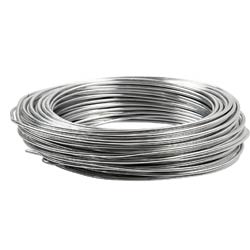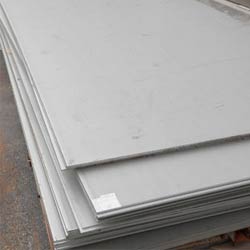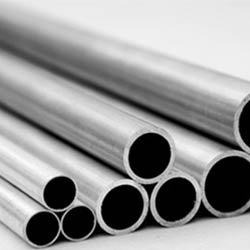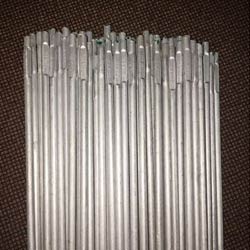Chemical Composition: The chemical composition aluminum as the primary element, along with alloying elements such as magnesium, silicon, and manganese. The specific composition may vary depending on the manufacturing process and desired properties.
Properties:
Applications:
Manufacturing: Aluminum wire is typically manufactured through processes such as extrusion or drawing, where the aluminum alloy is forced through a die to form the desired wire shape and size.
Availability: Aluminum wire is available from aluminum suppliers and manufacturers specializing in electrical conductors. It is supplied in various diameters and lengths to meet specific application requirements.
Cost: The cost of aluminum wire can vary depending on factors such as diameter, length, quantity, and market demand for aluminum products. However, aluminum is generally more cost-effective compared to other metals like copper for electrical applications.

| Property | Value |
|---|---|
| Chemical Composition: | |
| Aluminum (Al) | Balance (remainder) |
| Magnesium (Mg) | 0.6 - 1.2% |
| Silicon (Si) | 0.40 - 0.8% |
| Manganese (Mn) | 0.15 - 0.40% |
| Iron (Fe) | 0.0 - 0.70% |
| Others (Each) | ≤ 0.05% |
| Others (Total) | ≤ 0.15% |
| Mechanical Properties: | |
| Tensile Strength | 140 - 180 MPa (20,000 - 26,000 psi) |
| Yield Strength | ≥ 55 MPa (8,000 psi) |
| Elongation | ≥ 20% |
| Electrical Conductivity | 56 - 61% IACS (International Annealed Copper Standard) |
Chemical Composition: The chemical composition of aluminum round bars typically includes:
These alloying elements contribute to the strength, corrosion resistance, and other mechanical properties of the aluminum alloy.
Mechanical Properties:
Properties:
Applications:
Manufacturing: Aluminum round bars are typically manufactured through processes such as extrusion or rolling, followed by heat treatment to achieve the desired mechanical properties.
Availability: Aluminum round bars are available from aluminum suppliers and manufacturers in various diameters and lengths to meet specific application requirements.
Cost: The cost of aluminum round bars can vary depending on factors such as diameter, length, quantity, and market demand for aluminum products. However, aluminum is generally more cost-effective compared to other metals for many applications.

Chemical Composition: The chemical composition of aluminum strips, sheets, and plates typically includes:
These alloying elements contribute to the overall properties of the aluminum alloy, including strength, corrosion resistance, and formability.
Properties:
Applications:
Manufacturing: Aluminum strips, sheets, and plates are typically manufactured through processes such as rolling, extrusion, or casting, followed by heat treatment to achieve the desired mechanical properties.
Availability: Aluminum strips, sheets, and plates are available from aluminum suppliers and manufacturers in various thicknesses, widths, and lengths to meet specific application requirements.
Cost: The cost of aluminum strips, sheets, and plates can vary depending on factors such as thickness, size, quantity, and market demand for aluminum products.

Chemical Composition: The chemical composition of aluminum tubes and pipes typically includes:
These alloying elements contribute to the overall properties of the aluminum alloy, including strength, corrosion resistance, and formability.
Properties:
Applications:
Manufacturing: Aluminum tubes and pipes are typically manufactured through processes such as extrusion, seamless rolling, or welding, followed by heat treatment to achieve the desired mechanical properties.
Availability: Aluminum tubes and pipes are available from aluminum suppliers and manufacturers in various diameters, wall thicknesses, and lengths to meet specific application requirements.
Cost: The cost of aluminum tubes and pipes can vary depending on factors such as diameter, wall thickness, length, quantity, and market demand for aluminum products.

Chemical Composition: The chemical composition of aluminum fittings typically includes:
These alloying elements contribute to the overall properties of the aluminum alloy, including strength, corrosion resistance, and formability.
Properties:
Applications:
Manufacturing: Aluminum fittings are typically manufactured through processes such as extrusion, machining, or casting, depending on the specific requirements of the fitting.
Availability: Aluminum fittings are available from aluminum suppliers and manufacturers in various shapes, sizes, and configurations to meet specific application requirements.
Cost: The cost of aluminum fittings can vary depending on factors such as size, complexity, quantity, and market demand for aluminum products.

Chemical Composition: The chemical composition of aluminum flanges typically includes:
These alloying elements contribute to the overall properties of the aluminum alloy, including strength, corrosion resistance, and formability.
Properties:
Applications:
Manufacturing: Aluminum flanges are typically manufactured through processes such as extrusion, machining, or casting, depending on the specific requirements of the flange.
Availability: Aluminum flanges are available from aluminum suppliers and manufacturers in various sizes, configurations, and pressure ratings to meet specific application requirements.
Cost: The cost of aluminum flanges can vary depending on factors such as size, complexity, quantity, and market demand for aluminum products.

Chemical Composition: The chemical composition of aluminum welding rods typically includes:
These alloying elements contribute to the overall properties of the aluminum alloy, including strength, corrosion resistance, and weldability.
Properties:
Applications:
Manufacturing: Aluminum welding rods are typically manufactured from aluminum alloy billets through processes such as extrusion or drawing to achieve the desired rod diameter.
Availability: Aluminum welding rods are available from welding supply stores, aluminum suppliers, and manufacturers in various diameters to meet specific welding requirements.
Cost: The cost of aluminum welding rods can vary depending on factors such as diameter, length, quantity, and market demand for aluminum welding consumables.
